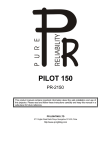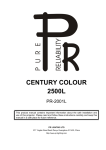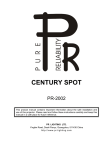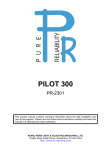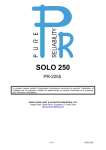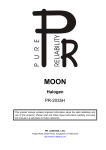Download Pure Acoustics DMX-50 Product manual
Transcript
PILOT 150 PR-2150 This product manual contains important information about the safe installation and use of this projector. Please read and follow these instructions carefully and keep this manual in a safe place for future reference. PEARL RIVER LIGHT & ACOUSTICS INDUSTRIAL LTD. Yingbin Road, Dashi Panyu, Guangzhou, 511430 China http://www.pr-lighting.com INDEX SECTION PAGE SAFE USAGE OF THE PROJECTOR INSTALLING THE PROJECTOR FITTING THE LAMP POWER SUPPLY – MAINS CONTROL CONNECTIONS SETUP OPTIONS – PROJECTOR CONFIGURATION DMX START ADDRESS DMX CONTROL CHANNEL FUNCTIONS MAINTENANCE CHANGING THE GOBOS LUBRIFICATION KEEPING THE PROJECTOR CLEAN TROUBLESHOOTING TECHNICAL DATA ELECTRICAL DIAGRAM COMPONENT ORDER CODES 3 4 4 5 5 6 6 7 8 8 8 9 9 10 11 12 Please note that as part of our ongoing commitment to continuous product development, specifications are subject to change without notice. Whilst every care is taken in the preparation of this manual we reserve the right to change specifications in the course of product improvement. The publishers cannot be held responsible for the accuracy of the information herein, or any consequence arising from them. Every apparatus is tested completely and packed properly by the manufacturer. Please make sure the packing and / or the apparatus is in good condition before your installation and use. Should there be any damage caused by transportation, consult your dealer and do not use the apparatus. But any damage caused by improper use will not be assumed by the manufacturer and / or dealer. ACCESSORIES THESE ITEMS ARE PACKED TOGETHER WITH THE PROJECTOR Mounting Bracket (1 PCS) M8x25 for mounting bracket (2 PCS) Power-cord (1 PCS) XLR plug (1 PCS) XLR socket (1 PCS) Safety cord (1 PCS) Spare gobos (4 PCS) This manual (1 PCS) INTRODUCTION Thank you for purchasing our PILOT 150 PR-2150. This product manual contains important information about the safe installation and use of this projector. Please read and follow these instructions carefully and keep this manual in a safe place for future reference. The PILOT 150 is an innovative projector with an elegant housing, which is made from high intensity and heat–resistant complex plastic. PILOT 150 compiles to CE norms and standards and uses international control protocol DMX 512. The projector may also be used as a stand-alone unit if desired, controlled by sound, and/or automatic internal programmes, so it is suitable for many different applications. PILOT 150 features 9 dichroic colours, 7 interchangeable rotating gobos, and an independent adjustable strobe/shutter. It can be setup easily via the touch-switches and digital display screen. 2/14 PILOT150 manual en.doc SAFE USAGE OF THE PROJECTOR When unpacking and before disposing of the carton check there is no transportation damage before using the projector. Should there be any damage caused by transportation, consult your dealer and do not use the apparatus. The projector is for Indoor use only, IP20. Use only in dry locations. Keep this device away from rain and moisture, excessive heat, humidity and dust. Do not allow contact with water or any other fluids, or metallic objects. The projector is only intended for installation, operation and maintenance by qualified personnel. The projector is not designed or intended to be mounted directly on to inflammable surfaces. The projector must be installed in a location with adequate ventilation, at least 50cm from adjacent surfaces. Be sure that no ventilation slots are blocked. Do not project the beam onto inflammable surfaces, minimum distance is 3m. 3m Avoid direct exposure to the light from the lamp. The light is harmful to the eye. Do not attempt to dismantle and/or modify the projector in any way. Electrical connection must only be carried out by qualified personnel. Before installation, ensure that the voltage and frequency of power supply match the power requirements of the projector. It is essential that each projector is correctly earthed and that electrical installation conforms to all relevant standards. Do not connect this device to any dimmer pack. Make sure that the power-cord is never crimped or damaged by sharp edges. Never let the powercord come into contact with other cables. Only handle the power-cord by the plug. Never pull out the plug by tugging the power-cord. The projector should always be installed with a secondary safety fixing. A safety cord is supplied for this, it should be attached as shown. The lamp used in this projector is an HTI 150W/DX discharge lamp. After being switched off don’t attempt to restart the projector until lamp has cooled, this will require approx 15 minutes. Switching the lamp on and off at short intervals will reduce the life of both the lamp and the projector. Never run the projector without a lamp. There are no user serviceable parts inside the projector, do not open the housing and never operate the projector with the covers removed. Always disconnect from the mains, when the device is not in use or before cleaning it or before attempting any maintenance work. If you have any questions, don’t hesitate to consult your dealer. 3/14 PILOT150 manual en.doc INSTALLING THE PROJECTOR Bracket Fixing Hole M8x25 Bolt M8x25 Bolt Pass safety fixing through these holes The projector should be mounted via its bracket using one M12 bolt. The bracket itself attaches to the underside of the projector with two (2) M8x25 bolts provided. Always ensure that the projector is firmly anchored to avoid vibration and slipping whilst operating. Always ensure that the structure to which you are attaching the projector is secure and is able to support a weight of 11.5Kg for each PILOT 150. For safety the projector should have a secondary fixing with a safety chain through the holes on the underside of the unit. WARNING: The projector should NEVER be lifted or carried by the yoke. FITTING THE LAMP HTI 150W LAMP LAMP ADJUSTMENT LAMP ADJUSTMENT Adjust lamp position by LAMP ADJUSTMENT turning screws A, B and C LAMP HOLDER ACCESS SCREW ACCESS SCREW ONLY USE REPLACEMENT LAMP TYPE: HTI 150W LAMP ACCESS HATCH LAMP ACCESS HATCH Open the lamp access hatch at the rear of the projector by undoing the 2 access screws as shown above. Insert an HTI 150W/DX lamp in the lamp holder. Close the access hatch carefully and retighten the 2 access screws. NOTE: To optimize light output it will be necessary to adjust the lamp alignment to obtain an even distribution of light within the beam. The three screws (marked A, B, and C) may be gently turned to center the lamp within the reflector. The projector should be switched on with the shutter open and the beam focused to do this, it is also advisable to allow the lamp 5 minutes to come up to full brightness before starting to align it. Note: the three screws will only need a small adjustment to centre the lamp, do not try to unscrew them completely. Read the rest of this manual and then come back to this section to align the lamp. The HTI series are high pressure lamps with external igniters . Care should always be taken when handling these lamps. Always read the manufacturers "Instructions for use" enclosed with the lamp. 4/14 PILOT150 manual en.doc POWER SUPPLY – MAINS L = BROWN E = GREEN/YELLOW N = BLUE FUSE HOLDER FUSE F6.3A/250V L E N Use the plug provided to connect the mains power to the projector paying attention to the voltage and frequency marked on the panel of the projector. It is recommended that each projector is supplied separately so that they may be individually switched on and off. IMPORTANT It is essential that each projector is correctly earthed and that electrical installation conforms to all relevant standards. Power consumption of the PILOT 150 is 280W. CONTROL CONNECTIONS DMX OUT DMX IN 1 1 2 2 PIN DMX 512 FUNCTION 1 2 3 GND DATA DATA + 3 3 Connection between controller and projector and between one projector and another must be made with 2 core screened cable, with each core having at least a 0.5mm diameter. Connection to and from the projector is via cannon 3 pin XLR plugs and sockets which are included with the projector. The XLR's are connected as shown in the table above. Note, care should be taken to ensure that none of the connections touch the body of the plug or each other. The body of the plug is not connected in any way. The PILOT 150 accepts digital control signals in standard DMX512 (1990) format. No. 1 DMX IN DMX OUT No. n No. 2 DMX IN DMX OUT DMX IN DMX IN FROM CONTROLLER DMX OUT TERMINATOR Connect the controller’s output to the first fixture’s input, and connect the first fixture’s output to the second fixture’s input. The rest may be deduced by analogy. Eventually connect the last fixture’s output to a DMX terminator as shown in the figure above. PILOT 150 uses 3-pin XLR plug / socket. If your controller uses 5-pin XLR plug / socket, you should use a conversion cable from 5-pin to 3-pin as shown bellow. 5 PIN SOCKET 3 PIN PLUG 5 PIN PLUG 3 PIN SOCKET Pin 1: GND (Screen) Pin 2: Signal (data -) Pin 3: Signal (data +) Pin 4: N/C Pin 5: N/C Pin 1: GND (Screen) Pin 2: Signal (data -) Pin 3: Signal (data +) Pin 1: GND (Screen) Pin 2: Signal (data -) Pin 3: Signal (data +) Pin 4: N/C Pin 5: N/C Pin 1: GND (Screen) Pin 2: Signal (data -) Pin 3: Signal (data +) When a DMX 512 signal is received the LED located near the digital display will illuminate green. When not receiving a DMX signal the green and red LEDs will be off, and if the green LED flashes, it means that the DMX signal is not correct. 5/14 PILOT150 manual en.doc DMX TERMINATOR At the last fixture in the chain, the DMX output has to be connected with a DMX terminator. This prevents electrical noise from disturbing and corrupting the DMX control signals. The DMX terminator is simply an XLR connector with a 120Ω (ohm) resistor connected across pins 2 and 3, which is then plugged into the output socket on the last projector in the chain. The connections are illustrated below. DMX TERMINATOR CONNECTION Connect a 120Ω(OHM) resistor across pins 2 and 3 in an XLR plug and insert into the DMX OUT socket on the last unit in the chain. PIN 3 PIN 2 SETUP OPTIONS – PROJECTOR CONFIGURATION To browse through the various Setup Options, press the FUNC button consecutively. There are 6 Option codes (1~6), and each code has a specific function. The functions provided are listed in the following table. SETUP OPTIONS CODE 1 2 CHOICE FUNCTION Y N Y N Reverse Tilt enable - Tilt is reversed Reverse Tilt disable - Tilt is normal Reverse Pan enable - Pan is reversed Reverse Pan disable - Pan is normal Microphone activation of Auto Programmes 1 & 2 Automatic programme 1 enable Automatic programme 2 enable Automatic programmes 1 or 2 Master / Slave operation of programmes 1 or 2 16bit Pan/Tilt movement resolution enable 16bit Pan/Tilt movement resolution disable 3 4 5 6 N Y N Y Y N Once you have selected the desired operation code, press the key UP or DOWN to select either “n” (means OFF) or “y “ (means ON). n = NO, y = YES. Press the key ENTER to save the selected function and configuration. If the display is showing “y”, then the setting has been enabled. In the same way, if it was showing “n” when you pressed ENTER the option has been disabled. The Red LED will flash during this operation. PROJECTOR DMX START ADDRESS GREEN LED FUNC RED LED DOWN UP ENTER Each PILOT 150 must be given a DMX start address so that the correct projector responds to the correct control signals. This DMX start address is the channel number from which the projector starts to “listen” to the digital control information being sent out from the controller. The PILOT 150 has 8 channels, so set the No. 1 projector’s address 001, No. 2 projector’s address 009, No. 3 projector’s address 017, No. 4 projector’s address 025, and so on. The display shows the DMX start address after the projector is switched on (if you have already set the DMX start address and saved it, the screen will display the last setting). TO SET THE DMX START ADDRESS Press the UP or DOWN buttons and the display will show the DMX start address. Confirm your choice by pressing the ENTER button, this will save and set the DMX start address. The display will show the latest setting each time the projector is powered up. 6/14 PILOT150 manual en.doc To control the projector with a DMX controller the DMX start address must be set. Ensure that none of the Stand-Alone options are set or they will interfere with correct DMX operation. DMX CONTROL CHANNEL FUNCTIONS The PILOT 150 uses 8 DMX channels. They are listed in the following table. CHANNEL 1 GOBO WHEEL 2 GOBO ROTATION 3 COLOUR WHEEL 4 STROBE 5 PAN 6 TILT 7 PAN 16BIT 8 TILT 16BIT DMX VALUE 0-33 34-66 67-99 100-132 133-165 166-199 200-232 233-255 0-8 9-163 164-205 206-213 214-255 0-27 28-55 56-83 84-111 112-139 140-167 168-195 196-223 224-251 252-255 0-21 022-110 111-135 136-247 248-255 0-255 0-255 0-255 0-255 DESCRIPTION Open / Clear (5-7 for 5 secs.) Soft reset – See Note GOBO 1 (Swirl) GOBO 2 (Tri-ring) GOBO 3 (Windmill) GOBO 4 (Multi-circle) GOBO 5 (Stars) GOBO 6 (Ring) GOBO 7 (Three-prong) Stop Orientation from 0°to 360° Rotate from slow to fast Stop Rotate in opposite direction from slow to fast Open (White) Red Yellow Light green Pink Ultraviolet colour Cyan Green Blue Orange Black-out Open gradually from black to full open (dimming) Open Strobe adjust from slow to fast (1 ~7 flashes / sec.) Open Pan movement from 0°to 370° Tilt movement from 0°to 265° 16 Bit Pan movement (High-resolution) 16 Bit Tilt movement (High-resolution) NOTE: Soft Reset – If the DMX value sent on this channel (1) stays in the range from 5 to 7 for more than 5 seconds, the projector will start a reset sequence (Remote Requested Reset). The electronics are restarted and all motors moved to their home positions exactly as they do when the power is first switched on but the lamp is not switched off in this sequence, although the beam will be blacked out. The channels 7 and 8 are only available when the Setup Option 6 (high resolution) is “ON”. For the exact setting refer to “Setup Options – Projector Configuration” above. STAND – ALONE MODE The projectors can operate without a controller. They can do this in one of 3 different ways. StandAlone Mode means automatic operation independent of other projectors and can either be automatic or triggered by music depending on the combination of Setup Options 4 and 5 that are selected. The projectors can also operate synchronously with each other in Master/Slave mode. To do this they must be connected together as described above in the Control Connections section with the terminator inserted in the output of the last slave projector in the chain but, of course, without the controller. The same type of DMX cables must be used to connect the Master with the Slaves. The appropriate Setup Options must also be set. See the section on “Setup Options – Projector Configuration” for full details of the available combinations. Select one projector as the Master, setting the DMX start address at random. Regard the other projectors as the slaves setting all DMX start addresses to “001”. Never have more than ONE (1) projector configured as Master or the system will not work. 7/14 PILOT150 manual en.doc MAINTENANCE If the projector’s lens becomes damaged or broken it should be replaced. If the lamp becomes damaged or deformed in any way it must be replaced. If the light from the lamp appears dim this would normally indicate that it is reaching the end of its life and it should be changed at once, old lamps run to the extremity of their life can explode. If the projector does not function, check the fuses on the power socket of the projector, they should only be replaced by fuses of the same specified value 6.3A/250V. On the main PCB inside the projector there is also a fuse rated 4A/250V. Should these be damaged call a qualified technician before replacement. The projector has thermal protection device that will switch off the projector in case of overheating, should either of these operate, check that the fans are not blocked, and if they are dirty clean them before switching on the projector again. Check that the fans are operational, if not call a qualified technician. Any maintenance work should only be carried out by qualified technicians. CHANGING THE GOBOS LOWER COVER (WITH PROTRUSION) GOBO RETAINING SPRING Carefully lift off the lower cover by undoing the 4 screws. (Note: the lower cover has an obvious protrusion on the surface, which is different from the upper cover.) Using a small screwdriver remove the gobo retaining spring. Insert the gobo (or a glass gobo) into position, and then insert the retaining spring. Mount the lower cover and tighten the 4 screws again. NOTE: It is recommended to add a little adhesive, such as high temperature silicon sealant, to hold securely the retaining spring inside the gear. LUBRIFICATION To ensure the continued smooth rotation of the rotating gobos it is recommended that the wheel is lubricated periodically, preferably every two months. Use only high working temperature low viscosity oil, a syringe with a fine needle is the easiest way to introduce the oil to the bearings around each gobo. Do not over lubricate as this will cause spillage when the wheel rotates. 8/14 PILOT150 manual en.doc KEEPING THE PROJECTOR CLEAN To ensure the reliability of the projector it should be kept clean. It is recommended that the fans should be cleaned every 15 days. The lens and dichroic colour filters should also be regularly cleaned to maintain an optimum light output. Do NOT use any type of solvent on dichroic colour filters. Cleaning frequency depends on the environment in which the fixture operates: damp, smoke or particularly dirty surroundings can cause greater accumulation of dirt on the unit’s optics. A soft cloth and typical glass cleaning products should be used in cleaning. It is recommended to clean the external optics at least once every 20 days and clean the internal optics at least once every 30 / 60 days. Do not use any organic solvent, e.g. alcohol, to clean the reflector mirror, dichroic color filters or housing of the apparatus. TROUBLESHOOTING PROBLEM The projector doesn’t switch on The lamp comes on but the projector doesn’t respond to the controller The projector only functions intermittently Defective projection POSSIBLE CAUSE -The power supply is not present -The lamp is not working -Wrong DMX configuration and/or start address - Defective DMX cable -The fan has failed -The lens is broken -Dust or grease on lenses The projected image appears to have a halo -Installation of the lamp is not correct -Dust or grease contamination on the optics. The beam appears dim -Dust or grease contamination on the optics. -The lamp is at the end of its life 9/14 ACTION Check the fuse on the power socket. Replace the lamp. Make sure that the projector is correctly configurated. Replace or repair the DMX cable. Make sure the fan is working and not dirty. Check the lenses are not broken. Remove dust or grease from the lenses. Make sure the lamp is installed correctly. Carefully clean the optical group lenses and the projector components. Check the optics are clean. Replace with a new lamp of the specified type and rating. PILOT150 manual en.doc TECHNICAL DATA VOLTAGES: 100/120/200/220/230/240V AC, 50Hz or 60Hz To Order. POWER CONSUMPTION: 280W @ 220V LAMP: Type : HTI 150W/DX discharge lamp. Colour Temperature: 6500ºK Socket: GY9.5 Manufacturers Rated Lamp Life: 750 Hours COLOURS: 9 Dichroic colours plus white GOBOS: 7 interchangeable, rotating gobos, with 4 extra supplied as standard. Gobo diameter: 27.9mm Gobo image diameter: 22mm SHUTTER/STROBE: Shutter for blackout and strobe 1 – 7 F.P.S. HEAD MOVEMENT: Pan 370º Tilt 265º BEAM ANGLE: 13º CONTROL: DMX512: 6 Channels plus 2 for Hi Res. Pan and Tilt Stand-Alone Automatic mode, Sound Activation and Master / Slave operation. MOTORS: 6 Stepper motors HOUSING: Metal and composite plastic (IP20) DIMENSIONS: See drawings below. WEIGHT: 12Kg. PACKED DIMENSIONS: 380mm LONG x 340mm WIDE x 470mm HIGH PACKED WEIGHT: 13.5Kg. DIMENSIONS 285 159 238 419 375 95 347 10/14 274 PILOT150 manual en.doc LIGHT OUTPUT 1200 lux 6m 300 lux 133 lux 75 lux 48 lux 5m 4m 3m 2m 1m 0m 13º 1m 2m 3m 4m 5m 6m 0m 5m BEAM DIAMETER Ø1.01m 10m 15m 20m 25m Ø2.1m Ø3.15m Ø4.2m Ø5.25m ELECTRICAL DIAGRAM 8 DC 24V 9 GOBO GOBO COLOUR WHEEL ROTATION WHEEL SHUTTER LOWER FAN TILT PAN UPPER FAN MOTOR MOTOR MOTOR MOTOR MOTOR MOTOR 2 3 4 5 6 1 BROWN ORANGE YELLOW RED BROWN ORANGE RED RED ORANGE YELLOW YELLOW ORANGE YELLOW RED BROWN RED YELLOW BROWN ORANGE BROWN GREY GREEN BROWN ORANGE - BLACK + RED A1 MAIN PCB B1 A2 B2 A3 A5 A4 B4 B3 B5 A7 A6 B7 B6 B9 B8 FUSE 4A - 250V C1 D1 16 PIN 3 21 C2 1 E1 AC C3 DMX C4 TRANSFORMER RED 21.5V 50W IGNITOR BALLAST GREEN D FUSE 6.3A - 250V THERMOSTAT 1 L 2 2 3 N DMX IN L N E 1 3 DMX OUT HTI 150W/DX CAP 20µF 2 3 4 5 6 DISPLAY PCB LED1 LED2 7 16 PIN 11/14 PILOT150 manual en.doc COMPONENT ORDER CODES FOR PR-2150 NO 1 NAME PART NO. REMARK 040020035 240V/50Hz 100V/200V/230V 50/60Hz 100V/120V/220V 50/60Hz 20µF/AC370V 240V/50Hz 220V-230V/50-60Hz 240V/50Hz 230V/50Hz 200V/60Hz 75ºC HTI 150W/DX 040020037 TRANSFORMER 040020033 2 CAPACITOR 3 BALLAST 4 IGNITOR 5 6 7 8 9 MOTOR 1 MOTOR 2 MOTOR 3 MOTOR 4 MOTOR 5 MOTOR 6 A1~A4 A5 A6 A7 B2, B2 B3 B4~B7 B8, B9 C1 C2 C3 C4 D1 E1 NOT SHOWN NOT SHOWN 140010011 040070027 040070022 040090017 040090014 040090018 190010066 100050014 191010028 030069005 030069006 030040070 030040057 030040057 030040072 030040054 030040029 170170003 170110004 170050001 170110004 170170037 170040014 170170037 170040014 170170039 170050001 170170012 170040033 230040109 170040035 290151202 290151208 THERMOSTAT LAMP TOUCH SWITCH FAN IN BASE FAN IN HEAD (GOBO-WHEEL) MOTOR (GOBO ROTATION) MOTOR (COLOUR-WHEEL) MOTOR (SHUTTER) MOTOR (PAN) MOTOR (TILT) MOTOR IC IC IC IC IC IC IC IC IC IC IC IC IC IC PAN DRIVE BELT TILT DRIVE BELT DC24V/2.4W DC24V/2.6W 16HY1405-01N 16HY7403-01 16HY7403-01 16HY7403-04 17HS3005 17HS1013 DRIVER CHIPS ARITH–AMPLIFIER CHIP DRIVER CHIP D/A CONVERSION CHIP TTL LOGIC CHIP D/A CONVERSION CHIP TTL LOGIC CHIP STABLE VOLTAGE CHIP ARITH–AMPLIFIER CHIP BUS CHIP EEPROM CHIP MICROPROCESSOR RESET CHIP 101MXL BELT (126 TEETH) 168MXL BELT (210 TEETH) NOTE: You may order all parts of the PILOT 150 besides those in the table listed above. When ordering please state the exact name and part number, if you know it or can find it in the table above, if you cannot find the name and part number above please give a full and clear description of the part and where it is located in the projector. Repairs must be carried out by a qualified technician. 12/14 PILOT150 manual en.doc 13/14 PILOT150 manual en.doc PEARL RIVER LIGHT & ACOUSTICS INDUSTRIAL LTD. Yingbin Road, Dashi, Panyu, Guangzhou ,China Post-Code: 511430 TEL: 020-8478-1888 FAX: 020-8478-6023 P/N: 321010042 Last Revision: 23:01:2003 14/14 PILOT150 manual en.doc














